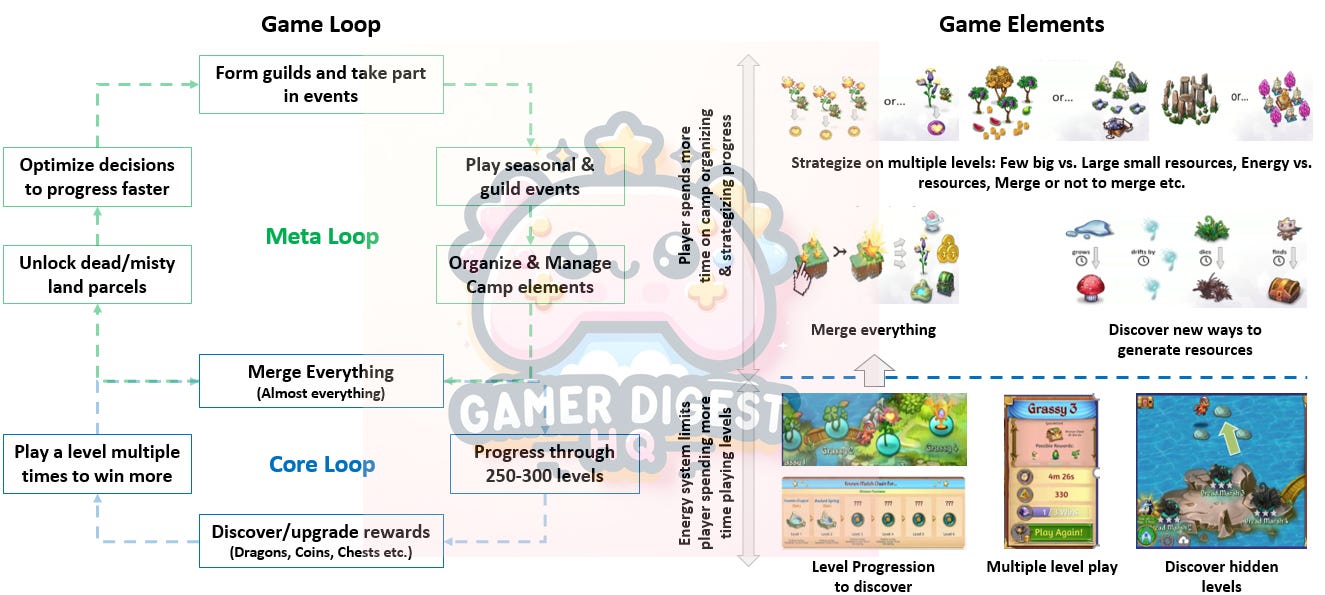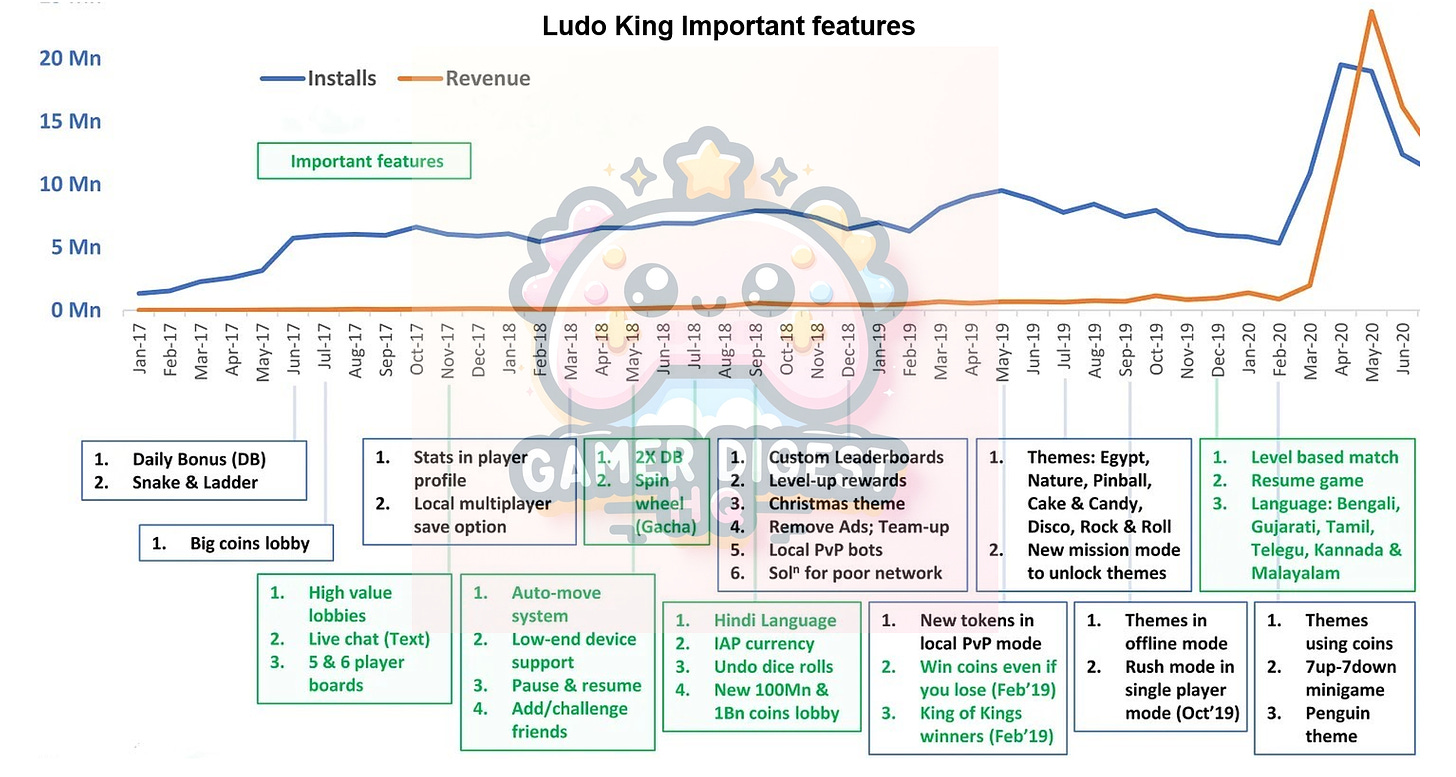
Coming up with a game idea
Journal 6 Saikat Mondal June 17
Hello and welcome to our exclusive series on mastering game development and launch! Today, we delve into one of our most challenging yet enlightening topics: conceptualizing your next groundbreaking game idea. This journey is uniquely creative and iterative, where no single step overshadows another. This post tries to outline comprehensive steps and essential concepts to inspire and guide you towards creating your next big hit.
Happy developing and stay inspired!
- Identify Your Core Expertise Genre: Understanding your strengths and preferences in game genres is vital in the highly competitive gaming market. This understanding forms the core foundation for developing a successful game. The significance of genre expertise is often reflected in the funding stages a game achieves, especially during the ideation or Beta launch phases.
A prime example of the impact of genre expertise is Dream Games. Their funding journey is a testament to the importance of having a clear genre focus:
- Seed Round (Nov’2019): Dream Games raised $7.5 million with just a game idea, no prototype or game developed yet. This initial funding highlights the value investors place on a solid, genre-specific game concept. (details here)
- Series A Funding (Feb’21): The company secured $50 million in Series A funding when they had preliminary metrics from a soft launch. This stage is crucial for scaling up user acquisition, even without concrete proof of potential success upon full-scale launch. (details here)
- Series B Funding (Jun’21): Just three months after Series A, Dream Games raised $155 million in a Series B funding round, catapulting their valuation to $1 billion. At this point, they demonstrated the scalability and potential of their game, earning them a significant valuation increase. (details here)
- Series C Funding (Jan’22): In a short span of six months, the company secured $255 million in Series C funding, bringing their total valuation to $2.75 billion. This is notable because only 0.1% of gaming companies achieve a valuation over $2 billion. For context, Peak Games, founded by the same team, was acquired by Zynga for $1.8 billion. (details here)
These funding rounds underscore the critical role of genre expertise in attracting investment and achieving high valuations in the gaming industry. Understanding and focusing on a specific game genre can significantly influence the success and financial backing of a game project.
The following graph indicates the growth of the title according to the funding stages.
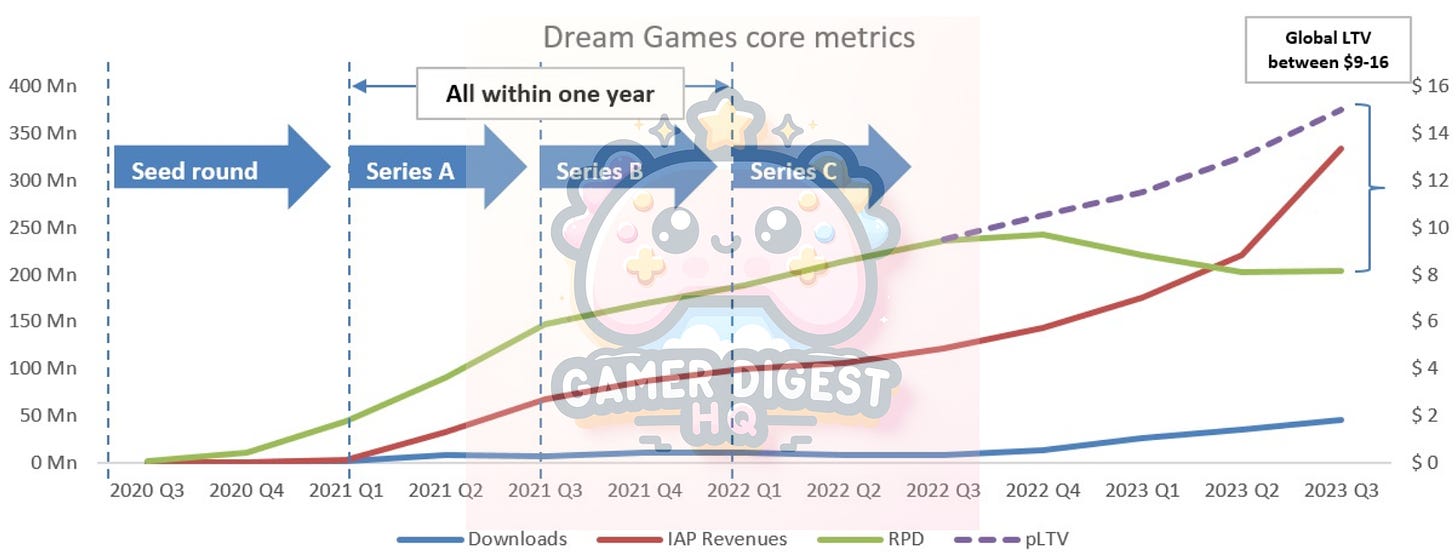
Vision: Dream Games aimed to provide high-quality gaming experiences to casual gamers, a segment often flooded with low-quality games. Their approach focused on “Evolution over innovation,” meaning they preferred incremental improvements over complete overhauls, and “Execution over ideas,” where player loyalty was more important than constantly introducing new games.
Founding Team: The founding team of Dream Games included CEO Soner Aydemir, who previously worked as a Product Director at Peak, along with Ikbal Namli, Hakan Saglam, Eren Sengul, and Serdar Yilmaz, who had extensive experience as engineering leads, product managers, and 3D artists at Peak. Their deep knowledge and passion for the Match Genre contributed to the success of their title “Royal Match.”
- Fusing mechanics with player instincts: Game developers and designers should not only focus on popular mechanics in their chosen genre but also consider those in other genres to provide players with a sense of familiarity. Crucially, identifying core human instincts and marrying them with game mechanics can introduce fresher feel to the content.
Successful Examples:
- Merge Dragons: Embraces the simple yet creative philosophy of “You can merge everything!” This is combined with the instinct of adventure and treasure hunting. Ray Mazza, the lead designer, drew inspiration from his childhood excitement of finding hidden treasures, mirroring this in the game’s cloud clearing and territory exploration mechanics.
- Candy Crush: Developed by King, this game aimed to be universally accessible (across platforms like Facebook, mobile, and browsers) and relatable, using the popular match-3 mechanic. Its theme of candy taps into the longstanding human fascination with sweets, making gameplay a virtual candy-tasting experience.
Understanding Human Instincts:
Human instincts often comprise multiple base traits and desires. Utilizing frameworks like Quantic Foundry’s can assist in pinpointing these core traits to target in game design.
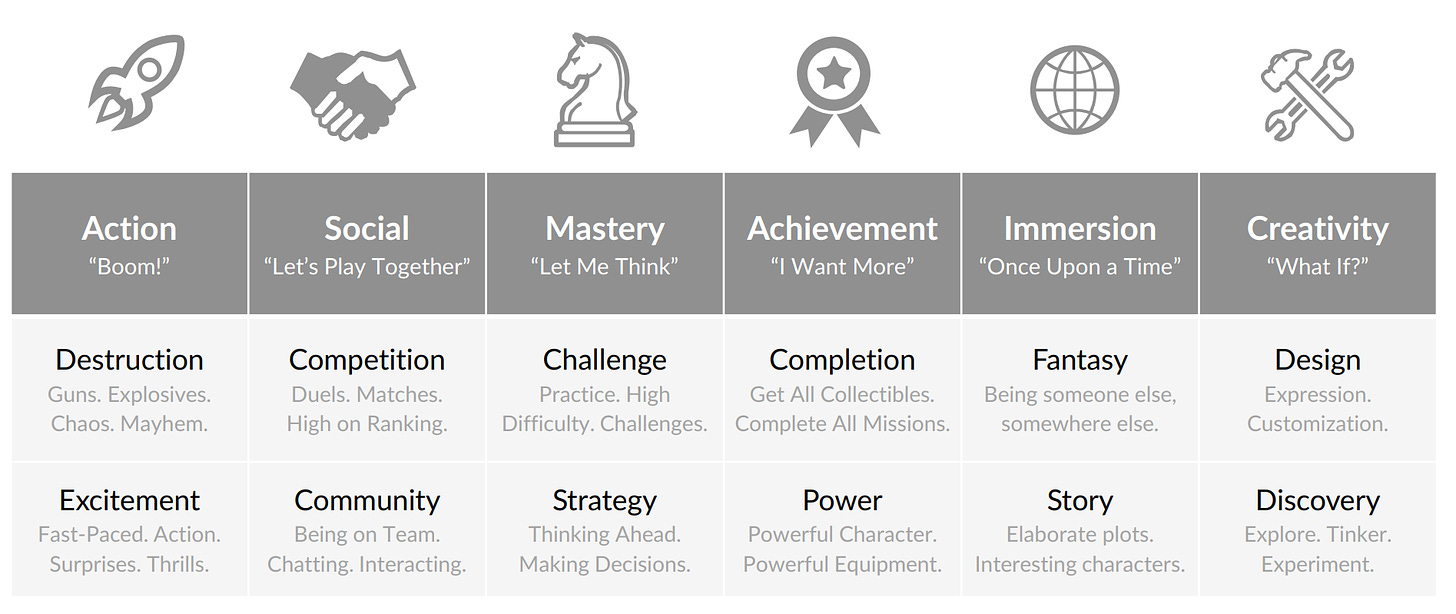
- Identify the core market trends: Staying on top of the most popular games in your genre of choice is always helpful. The best way to do market research is follow the top downloaded and top grossing games (from any of the 3rd party app analystics platform such as Data.ai, Sensor Tower, Appmagic, Gamalytic, Romonitor, SteamDB etc.) and play them individually to experience the core differentiating points on each of those games (There is no substitute for playing games). In addition to the above sources you could gain inspiration by looking at the trends on some of the popular browser based platforms such as Crazy Games, Gamezop, Poki etc. on what players are playing on browsers based games. Some popular indie marketplaces can also give you a good grasp on what others are working on regular visits to itch.io could give you some amazing ideas.
Following is one example on how to analyze the “Merge” genre and trying to identify the next idea for your game and the questions you are trying to get an answer to:
- Question 1: How strong is the genre?
Metric to measure: The number of successful launches along with installs and revenue growth of the genre indicates the overall relatability of the mechanic
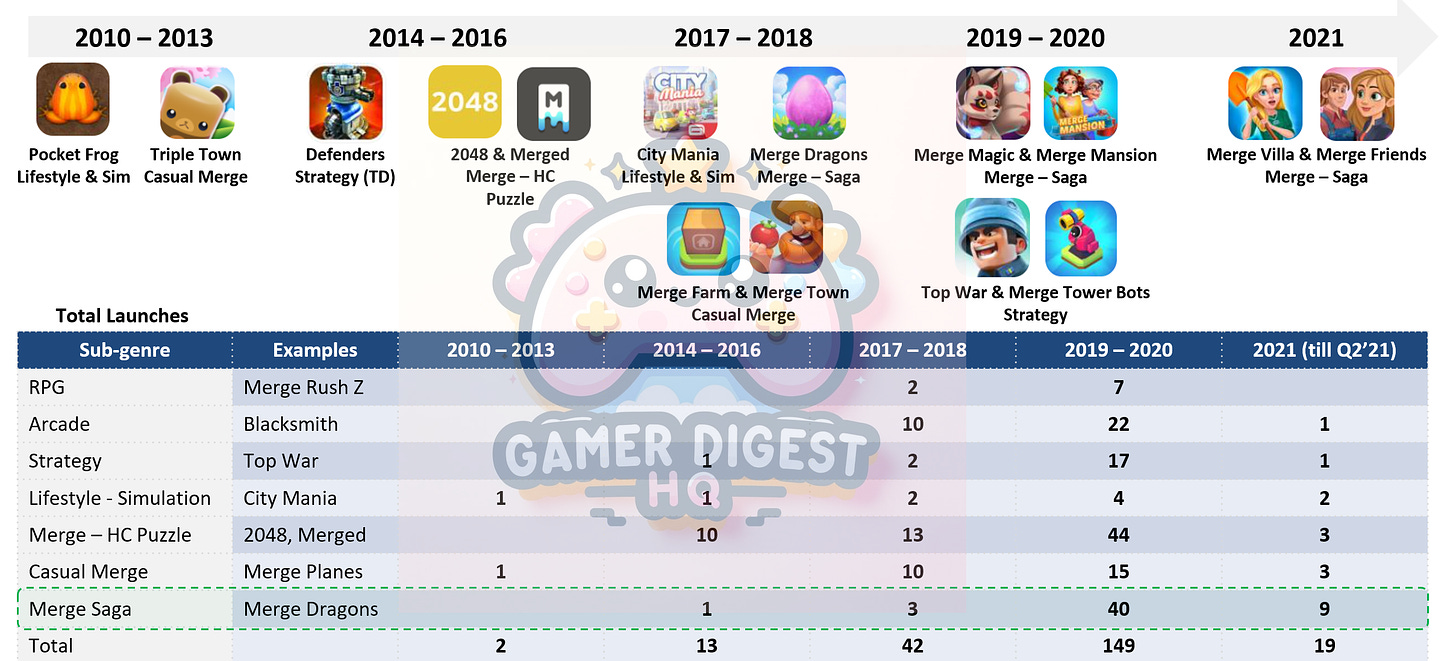
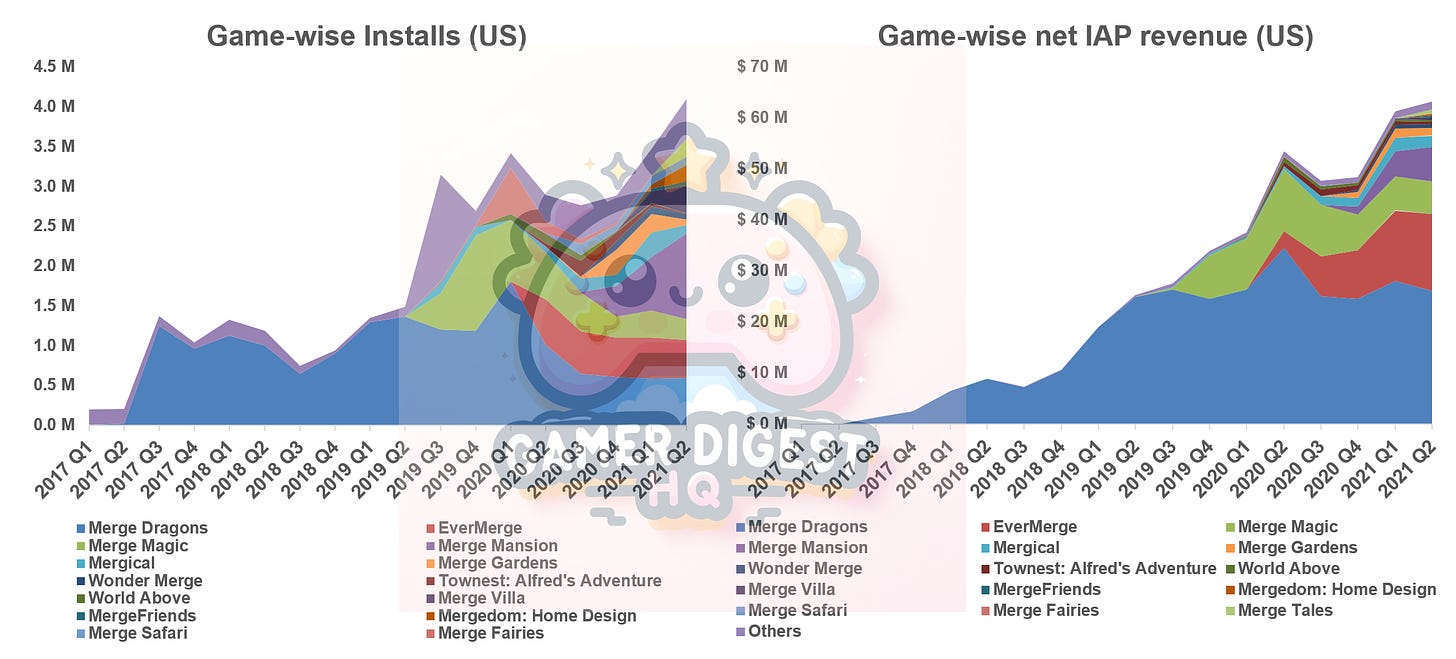
- Question 2: How does the current versions of the product differ from each other?
Understanding how different versions in the same game genre vary requires a detailed examination of their product loops. This analysis helps identify the fundamental human instincts the game targets.
Case Study – Merge Dragons vs. Candy Crush Saga:
- Merge Dragons: Having only 250-300 levels, Merge Dragons focuses on encouraging players to engage more with the Meta layer. Estimates suggest that elder players spend about 80% of their playtime in the Meta loop, aligning with the game’s aim to inspire exploration and a treasure hunt feel.
- Candy Crush Saga: In contrast, with over 14,500 levels across 968 episodes (probably more by now, source), Candy Crush emphasizes continuous gameplay centered around its core theme of matching candies.
Insight: These examples highlight how different games prioritize various aspects of gameplay – whether it’s the exploratory Meta layer in Merge Dragons or the extensive level-based core loop in Candy Crush Saga.

- Question 3: What are some of the gaps and pain points users have that you can fill?
Doing a deep research on Discord channels, Reddit, Quora, Fb Pages, App Store Reviews etc. can give meaningful insights on player behavior. For instance on Merge Dragons, players interacted with bubbled assets in the meta layer by creating ASMR designs or showing high degree of OCD and battle with the game to keep things organized (from my personal experience I must say this was incredibly hard!!). This example is just a basic analysis for your game, it is encouraged to a more nuanced research and getting very deep insights on what users are actually seeking from your game.
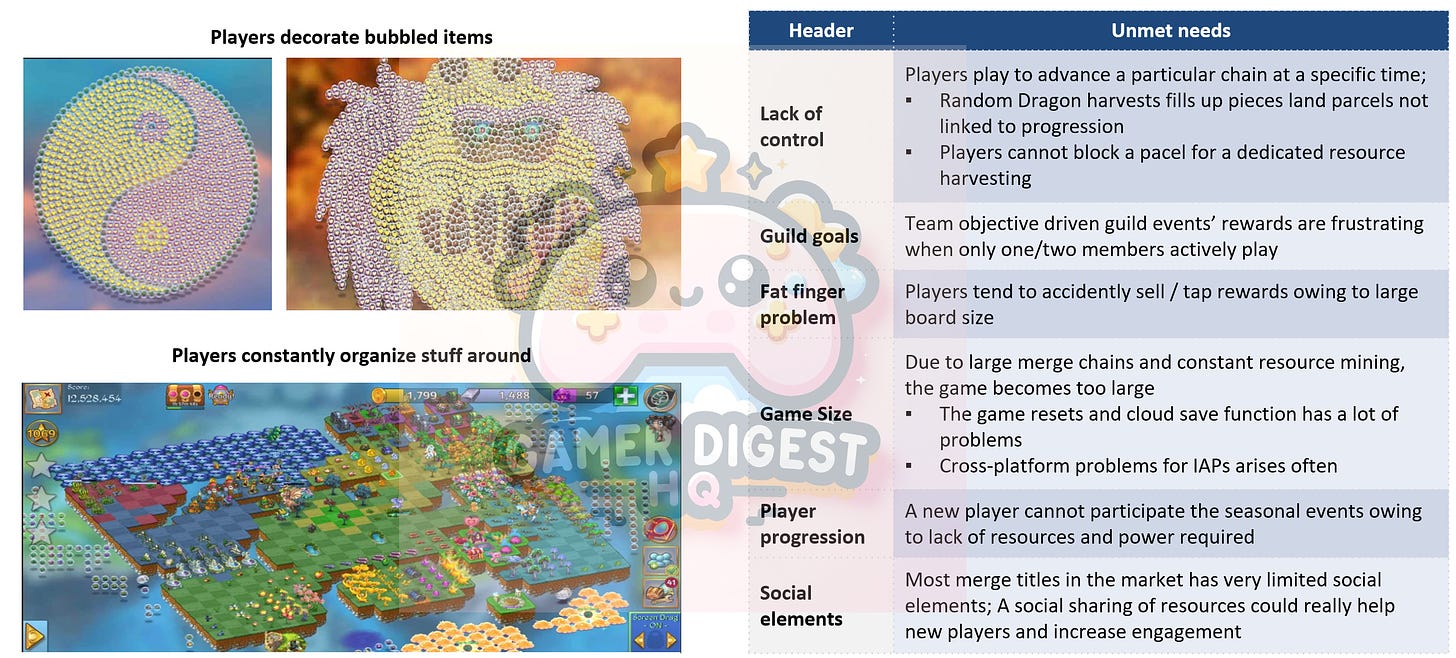
- Question 4: How to think about what features to add in the game?
For a comprehensive understanding of the competitive landscape in game development, tools like Data.ai and Sensor Tower are invaluable. They offer deep insights into market dynamics and competitor strategies.

- Tracking App Changes: One effective approach is to monitor all app-level changes and updates of competitors. This includes observing the subsequent uplift in their metrics, such as user engagement or revenue.
- Analyzing Major Updates: Identify and examine major updates in competitor games. Understand how these updates impact their installs and revenues.
- Contextual Comparison: It’s crucial to compare these changes not just in isolation but against the overall installs and revenues within the game’s genre. This broader comparison yields more nuanced insights, helping to pinpoint which game features are most effective and why.
- Question 5: What additional white spaces do you think you could explore?
For game developers, especially those with live games and trackable metrics, it’s essential to consider deeper, more strategic questions. These include identifying potential underserved markets for profitable entry and exploring unique approaches in User Acquisition (UA) and marketing for long-term branding.
- Case Studies in Strategic Market Entry:
- Gameberry and Yalla: These companies successfully penetrated the underserved Middle Eastern and European gaming markets, a strategy reflected in their significant install shares. This tactical move allowed them to establish a foothold in regions with less competition.
- Gametion’s Dominance: In contrast, Gametion’s established market leadership in India presented a challenging environment for new competitors. The case of Gameberry and Yalla demonstrates how recognizing and entering underserved markets can provide early growth opportunities and enable catching up with market leaders like Gametion.
- Case Studies in Strategic Market Entry:
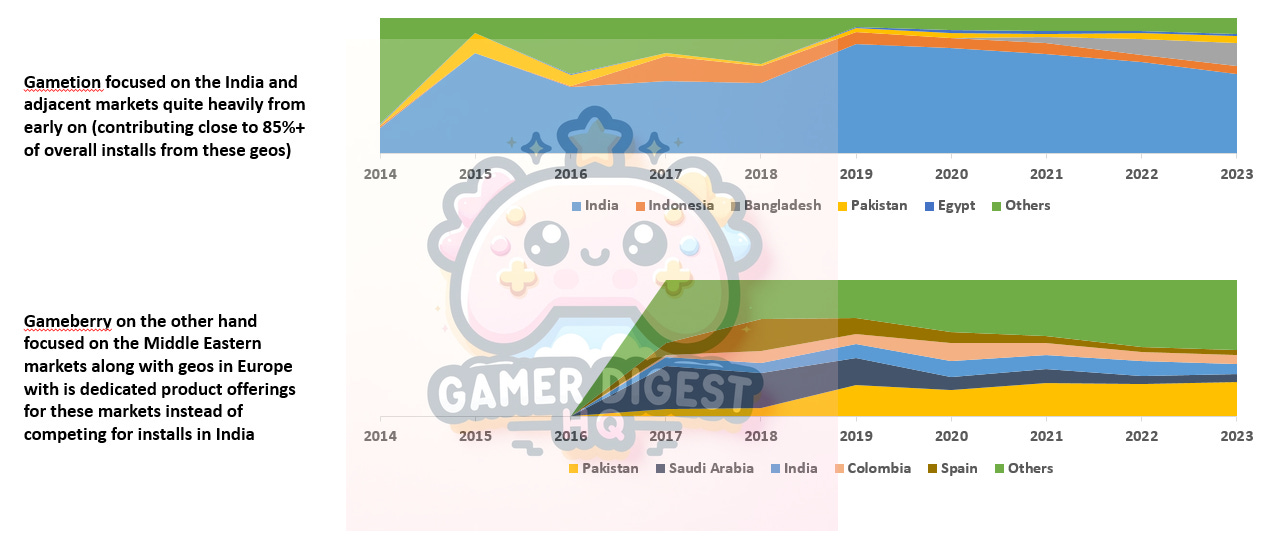
- Using mind map frameworks to incrementally innovate on the existing games: Delve into the time-honored SCAMPER method for generating game ideas. This acronym represents a systematic approach to creativity, encompassing Substitute, Combine, Adapt, Modify, Put to another use, Eliminate, and Reverse. Each element of SCAMPER provides a unique lens through which to re-envision and innovate game concepts, encouraging developers to explore new possibilities and variations in game design.

- Rapid prototyping: Prototyping in the early stages of game development varies among developers, yet it’s a crucial step for gathering valuable feedback. Whether it’s from a small group of talented in-house designers or through guidance from mentors, publishers, or advisors, prototyping is a vital tool.
- Rovio’s Success Story: Before the global success of Angry Birds, Rovio was a small studio exploring numerous ideas – 51 different games, in fact, none of which succeeded. The turning point came with a simple concept sketch of a bird that’s angry (for some reason!), sparking a series of events that led to the creation of the widely beloved Angry Birds franchise. This exemplifies how a single creative idea can revolutionize a company’s trajectory.
- Gram Games’ Innovative Approach: Gram Games fostered a unique company culture where new ideas were actively encouraged. Implementing a process where Fridays were dedicated to pitching new game concepts, employees were motivated to develop and present prototypes. This approach not only fueled creativity but also ensured continual idea generation and team involvement in the decision-making process.
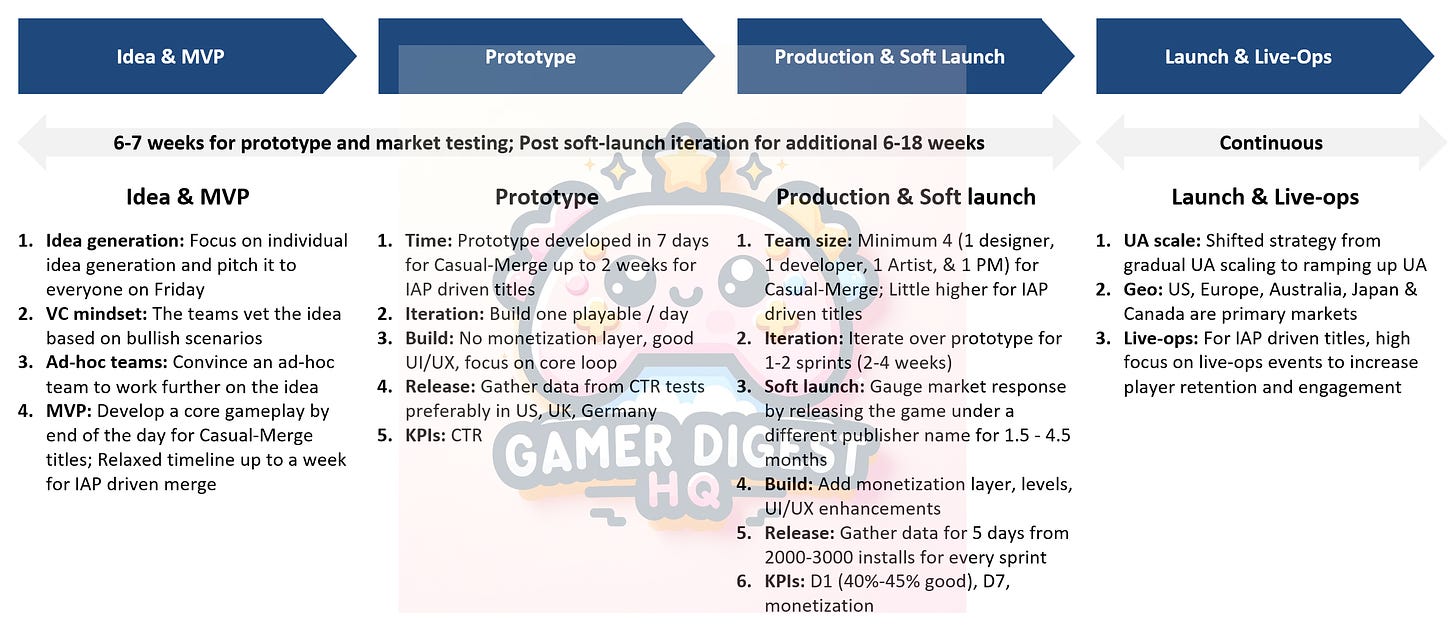
Notable mentions:
- Community Engagement: Staying connected with a community is crucial. It provides immediate feedback and keeps you informed about the latest industry trends, ensuring your game development is aligned with player expectations and market dynamics.
- Social Media Analysis: Utilizing platforms like YouTube, Pinterest, TikTok, and Instagram for social media searches is invaluable. It helps you understand consumer interactions and preferences in the broader Internet media landscape, offering insights into player interests and behaviors.
- Board Game Inspiration: Analyzing popular board games to understand why they captivate players can be enlightening. Emulating successful elements from these games can significantly enhance player engagement in your next Free-to-Play (F2P) game.
- Browser-Based Prototyping: Utilizing browser-based gaming platforms for prototyping can be a cost-effective strategy. It allows for testing the game’s core loop without the extensive resource investment typically required for full-scale development and marketing.


